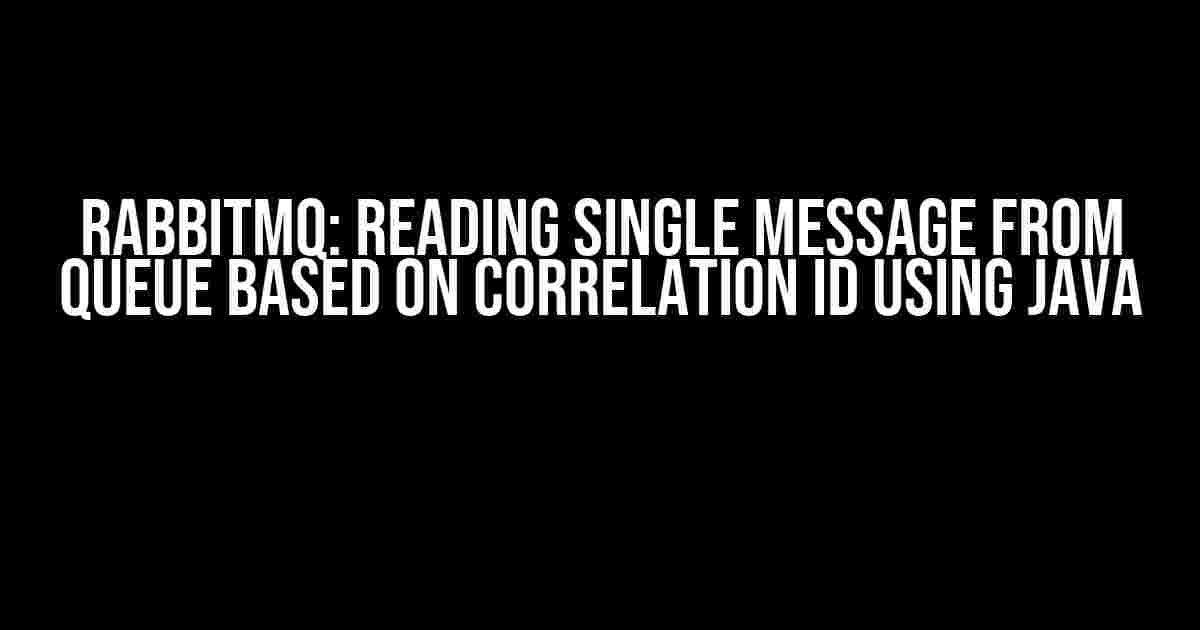Welcome to this comprehensive guide on how to read a single message from a RabbitMQ queue based on a correlation ID using Java. In this article, we will delve into the world of RabbitMQ and explore the steps necessary to achieve this crucial task. By the end of this tutorial, you will be well-equipped to handle message correlation like a pro!
What is RabbitMQ?
RabbitMQ is an open-source message broker that enables you to decouple your applications and services, allowing them to communicate with each other asynchronously. It’s built on top of the Advanced Message Queuing Protocol (AMQP) and provides a robust and scalable messaging system.
What is Correlation ID?
In RabbitMQ, a correlation ID is a unique identifier that links a request message to a response message. When you send a message to a RabbitMQ queue, you can specify a correlation ID, which allows the recipient to correlate the response message with the original request.
Why Use Correlation ID?
Using correlation IDs provides several benefits, including:
- Message tracking**: Correlation IDs enable you to track messages as they flow through your system, making it easier to debug and troubleshoot issues.
- Request-response mapping**: Correlation IDs help you map responses to their corresponding requests, ensuring that your system processes messages correctly.
- Improving system reliability**: By using correlation IDs, you can implement retry mechanisms and ensure that messages are not lost or duplicated during processing.
Reading a Single Message from a Queue based on Correlation ID using Java
To read a single message from a RabbitMQ queue based on a correlation ID using Java, you’ll need to follow these steps:
- Install the RabbitMQ Java Client
- Create a RabbitMQ Connection
- Declare the Queue and Bind it to the Exchange
- Read a Single Message from the Queue based on Correlation ID
First, you’ll need to install the RabbitMQ Java client. You can do this by adding the following dependency to your `pom.xml` file (if you’re using Maven) or your `build.gradle` file (if you’re using Gradle):
<dependency> <groupId>com.rabbitmq</groupId> <artifactId>rabbitmq-client</artifactId> <version>4.17.0</version> </dependency>
dependencies {
implementation 'com.rabbitmq:rabbitmq-client:4.17.0'
}
Next, you’ll need to create a RabbitMQ connection using the Java client. Here’s an example:
import com.rabbitmq.client.ConnectionFactory;
import com.rabbitmq.client.Connection;
public class RabbitMQConnection {
public static void main(String[] args) {
ConnectionFactory factory = new ConnectionFactory();
factory.setHost("localhost");
factory.setUsername("guest");
factory.setPassword("guest");
try (Connection connection = factory.newConnection()) {
// Use the connection to read messages from the queue
} catch (Exception e) {
e.printStackTrace();
}
}
}
Before reading messages from the queue, you need to declare the queue and bind it to an exchange. Here’s an example:
import com.rabbitmq.client.Channel;
import com.rabbitmq.client.QueueDeclareOk;
public class RabbitMQConnection {
public static void main(String[] args) {
// Create a connection as shown above
try (Channel channel = connection.createChannel()) {
// Declare the queue
QueueDeclareOk queueDeclareOk = channel.queueDeclare("my_queue", true, false, false, null);
// Bind the queue to the exchange
channel.queueBind(queueDeclareOk.getQueue(), "my_exchange", "", "", true);
} catch (Exception e) {
e.printStackTrace();
}
}
}
Now, let’s read a single message from the queue based on a correlation ID. You can do this using the `basicGet` method, which retrieves a single message from the queue:
import com.rabbitmq.client.BasicGet;
import com.rabbitmq.client.BasicProperties;
public class RabbitMQConnection {
public static void main(String[] args) {
// Create a connection and declare the queue as shown above
try (Channel channel = connection.createChannel()) {
// Set the correlation ID
String correlationId = "my_correlation_id";
// Define the message properties
BasicProperties props = new BasicProperties.Builder()
.correlationId(correlationId)
.build();
// Read a single message from the queue
BasicGet response = channel.basicGet("my_queue", true);
// Check if the message was found
if (response != null) {
System.out.println("Message found: " + new String(response.getBody()));
} else {
System.out.println("Message not found");
}
} catch (Exception e) {
e.printStackTrace();
}
}
}
Tips and Best Practices
When working with RabbitMQ and correlation IDs, keep the following tips and best practices in mind:
- Use unique correlation IDs**: Ensure that correlation IDs are unique across your system to avoid message mismatching.
- Implement retry mechanisms**: Use retry mechanisms to handle cases where messages are lost or duplicated during processing.
- Monitor queue lengths**: Monitor queue lengths to detect potential issues and ensure that messages are processed efficiently.
- Use message headers**: Use message headers to store additional metadata, such as the correlation ID, to facilitate message processing.
Conclusion
In this article, we’ve explored the process of reading a single message from a RabbitMQ queue based on a correlation ID using Java. By following these steps and best practices, you’ll be well-equipped to handle message correlation in your RabbitMQ-based applications.
| Keyword | Description |
|---|---|
| RabbitMQ | An open-source message broker |
| Correlation ID | A unique identifier linking a request message to a response message |
| basicGet | A method used to retrieve a single message from a RabbitMQ queue |
I hope you found this article informative and helpful. Happy coding!
Frequently Asked Question
RabbitMQ is a powerful message broker that enables you to handle a high volume of messages efficiently. However, when it comes to reading a single message from a queue based on a correlation ID using Java, things can get a little tricky. Here are some frequently asked questions about RabbitMQ and their answers to help you out!
How do I read a single message from a RabbitMQ queue based on a correlation ID using Java?
You can use the `Basic.Get` method provided by the RabbitMQ Java client to read a single message from a queue based on a correlation ID. You’ll need to set the `correlationId` property of the `GetRequest` object to the desired correlation ID, and then call the `basicGet` method on the `Channel` object. Here’s some sample code to get you started: `GetResponse response = channel.basicGet(queueName, true); String correlationId = response.getMessageProperties().getCorrelationId();`
How do I handle the case where the message with the specified correlation ID is not found in the queue?
When you call the `basicGet` method, RabbitMQ will return `null` if the message with the specified correlation ID is not found in the queue. You can handle this case by checking if the `GetResponse` object is `null` before attempting to access the message properties. For example: `if (response == null) { System.out.println(“Message not found”); } else { String correlationId = response.getMessageProperties().getCorrelationId(); }`
Can I use the `Basic.Consume` method to read a single message from a queue based on a correlation ID?
No, the `Basic.Consume` method is used to establish a consumer that will receive messages from a queue continuously. It’s not suitable for reading a single message from a queue based on a correlation ID. Instead, you should use the `Basic.Get` method, which is designed for this specific use case.
How do I specify the timeout for the `Basic.Get` method when reading a single message from a queue?
You can specify the timeout for the `Basic.Get` method by setting the `timeout` property of the `GetRequest` object. For example: `GetRequest request = new GetRequest(queueName, true); request.setTimeout(5000); // 5 seconds GetResponse response = channel.basicGet(request);`
What happens if multiple messages in the queue have the same correlation ID?
When you read a single message from a queue based on a correlation ID, RabbitMQ will return the first message that matches the specified correlation ID. If there are multiple messages with the same correlation ID in the queue, you may not get the message you expect. To avoid this issue, make sure to use unique correlation IDs for each message.



